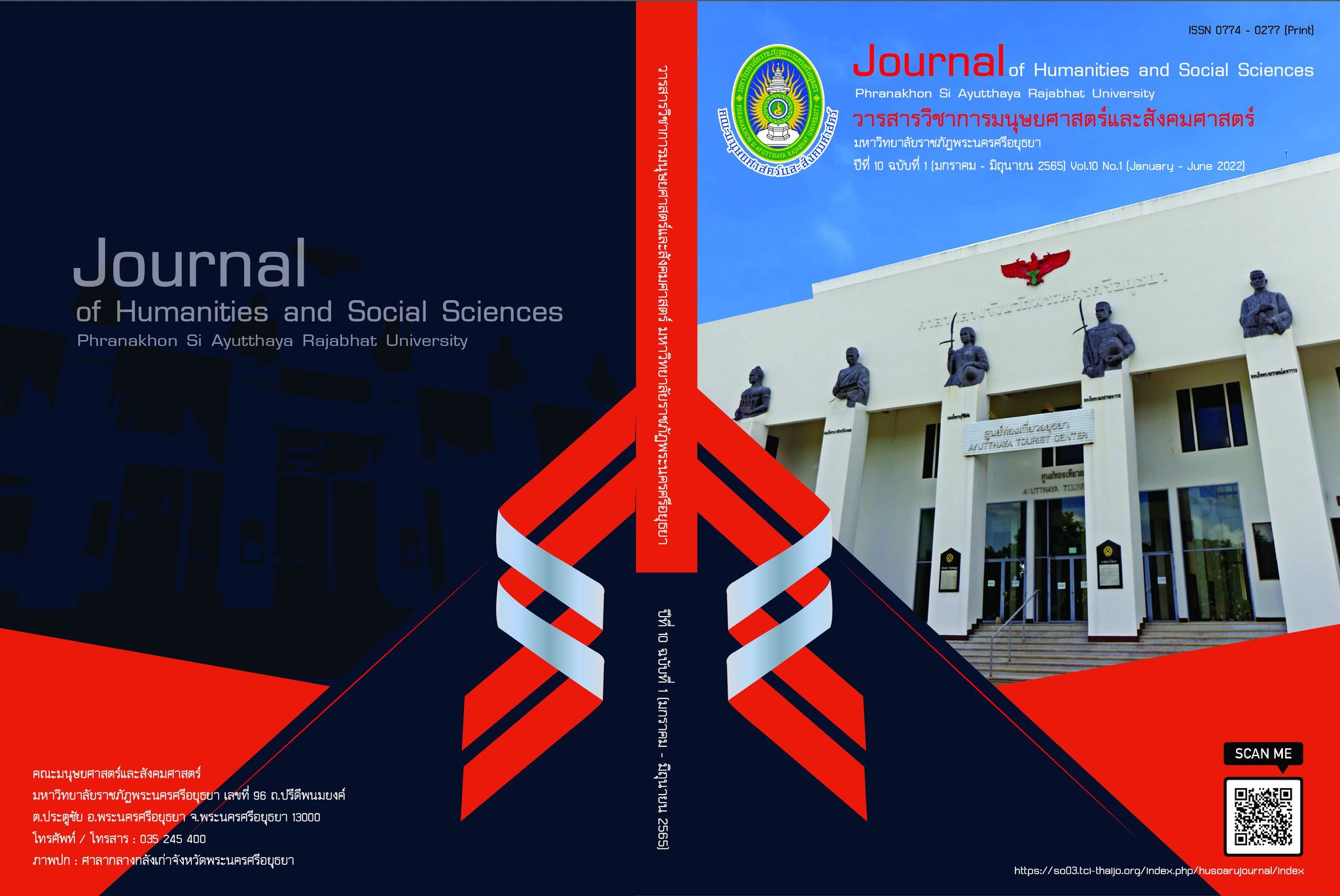ถอดรหัสทุนนิยมในแอนิเมชั่น Spirited Away
Main Article Content
บทคัดย่อ
ในสถานการณ์การระบาดของโรคโควิด-19 ที่ยาวนานต่อเนื่องมากว่าสองปีทำให้คนทำงานต้องทำงานอยู่ที่บ้าน และเด็ก ๆ ก็ต้องเรียนผ่านระบบออนไลน์ ความบันเทิงในรูปแบบของออนไลน์สตรีมมิ่งจึงเป็นที่นิยมมากขึ้น การดูภาพยนตร์พร้อมกันในครอบครัวที่บ้านจึงเป็นโอกาสอันดีที่ผู้ปกครองจะได้ใช้เวลาอย่างมีคุณภาพกับบุตรหลาน และช่วยพัฒนาการเรียนรู้ให้เด็ก ๆ ภาพยนตร์แอนิเมชันเรื่อง Spirited Away (2001) เป็นหนึ่งในภาพยนตร์ที่ได้รับการแนะนำอยู่เสมอ ภาพยนตร์เรื่องนี้ได้รับคำชื่นชมและได้รับรางวัลจากหลากหลายสถาบัน ทั้งในด้านภาพที่สวยงาม เนื้อเรื่องที่น่าตื่นเต้น และความบันเทิงที่เหมาะกับทุกวัย แต่ภาพยนตร์แอนิเมชันเรื่องนี้ยังได้สอดแทรกเนื้อหาและบทเรียนที่เกี่ยวข้องกับระบบทุนนิยมซึ่งเป็นสิ่งที่เด็กควรตระหนักถึง ในงานวิจัยครั้งนี้จึงมีจุดประสงค์เพื่อวิเคราะห์ความหมายของสัญลักษณ์ที่เกี่ยวข้องกับระบบทุนนิยมที่แฝงอยู่ในภาพยนตร์แอนิเมชันเรื่อง Spirited Away เพื่อเป็นข้อมูลให้ผู้อ่านสามารถนำไปประยุกต์ใช้ในการสอนโดยใช้ภาพยนตร์เป็นสื่อ จากการวิจัยพบว่าผู้กำกับภาพยนตร์ได้สอดแทรกภาพสะท้อนของทุนนิยมซึ่งรวมถึงลัทธิบริโภคนิยมและความโลภผ่านเรื่องราว ฉาก ตัวละคร และบทสนทนา ด้วยศิลปะอย่างแนบเนียน
Article Details

อนุญาตภายใต้เงื่อนไข Creative Commons Attribution-NonCommercial-NoDerivatives 4.0 International License.
บทความที่ได้รับการตีพิมพ์เป็นลิขสิทธิ์ของ คณะมนุษยศาสตร์และสังคมศาสตร์ มหาวิทยาลัยราชภัฏพระนครศรีอยุธยา
ทัศนะและความคิดเห็นที่ปรากฏในบทความในวารสารฯ ถือเป็นความรับผิดชอบของผู้เขียนบทความ และไม่ได้เป็นทัศนะและความรับผิดชอบของ กองบรรณาธิการ หรือ ของ มหาวิทยาลัยราชภัฏพระนครศรีอยุธยา
เอกสารอ้างอิง
Adachi, R. (2016). Dubbing of silences in Hayao Miyazaki’s Spirited Away: A comparison of Japanese and English language versions. Perspectives, 24(1), 142-156.
Artz, L. (2015). Animating transnational capitalism. Journal of Intercultural Communication Research, 44(2), 93-107. Retrieved March 1, 2022, from https://doi.org/10.1080/17475759.2015.1025817.
Berger, A. A. (2012). Media analysis techniques (4th ed.). Singapore: Sage.
Boyd, J. W., & Nishimura, T. (2016). Shinto perspectives in Miyazaki's anime film "Spirited Away". Journal of Religion & Film, 8(3), 4.
Brooks, X. (2005). A god among animators. Retrieved March 1, 2022, from https://www.theguardian.com/film/2005/sep/14/japan.awardsandprizes
Brown, M. (2016). Mulholland drive leads the pack in list of 21st century's top films. Retrieved March 1, 2022, from https://www.theguardian.com/film/2016/aug/23/mulholland-drive-david-lynch-21st-century-top-films-bbc-poll
Chandler, D. (2017). Semiotics for beginners. Retrieved March 1, 2022, from http://visual-memory.co.uk/daniel/Documents/S4B/sem13.Html#Heath_1981
Collin, R. (2014). Hayao Miyazaki interview: 'I think the peaceful time that we are living in is coming to an end'. Retrieved March 1, 2022, from http://www.telegraph.co.uk/culture/film/10816014/Hayao-Miyazaki-interview-I-think-the-peaceful-time-that-we-are-living-in-is-coming-to-an-end.html
Cooper, D. (2010). Finding the spirit within: A critical analysis of film techniques in Spirited Away. Retrieved March 1, 2022, from https://eric.ed.gov/?id=EJ910870
Croteau, D., Hoynes, W., & Milan, S. (2012). Media/society (4th ed.). Singapore: Sage.
Danesi, M. (2009). Semiotics of media and culture. In P. Cobley (Ed.), The Routledge Companion to Semiotics. New York: Routledge.
Dargis, M., & Scott, A. O. (2017). The 25 best films of the21st century so far. Retrieved March 1, 2022, from https://www.nytimes.com/interactive/2017/06/09/movies/the-25-best-films-of-the-21st-century.html
Davies, R. J., & Ikeno, O. (2002). The Japanese mind: Understanding contemporary Japanese culture. China: Turtle.
Dirk, T. (2017). Animated films. Retreived March 1, 2022, from http://www.filmsite.org/animatedfilms.html
D’Souza, J. (2015). Greed: Crises, causes, and solutions. International Journal of Humanities and Social Science, 5(7), 1-5.
Dugdale, H. (n.d.). Spirited Away. Retrieved March 1, 2022, from http://www.filmeducation.org/ pdf/film/SpiritedAway.pdf
Ebert, R. (2002). Hayao Miyazaki interview. Retrieved March 1, 2022, from https://www.rogerebert.com/interviews/hayao-miyazaki-interview
Eco, U. (1979). A theory of semiotics. Indiana: Indiana University Press.
Firat, A., Kutucuoglu, K. Y., Saltik, I. A., & Tuncel, O. (2013). Consumption, consumer culture and consumer society.Journal of Community Positive Practices, 13(1), 182-203.
Fromm, E. (1939). Selfishness and self-love. Psychiatry, 2(4), 507.
Ghibi Studio (Producer), & Miyazaki, H. (Director). (2001). Spirited Away [Motion Picture]. Japan: Ghibli Studio.
Hall, S. (1980). Encoding/decoding. In S. Hall, et al., (Eds.). Culture, media, language: Working papers in cultural studies, 1972-79, (pp.117-127). New York, NY: Centre for Contemporary Cultural Studies, University of Birmingham.
Hall, S. (2005). Media Education Foundation: Transcript. Retrieved March 1, 2022, from http://www.mediaed.org/transcripts/Stuart-Hall-Representation-and-the-Media-Transcript.pdf
Heilbroner, R. L. (2017). Capitalism. In Encyclopædia Britannica. Retrieved March 1, 2022, from https://www.britannica.com/topic/capitalism
IMDb. (2022). Sen to Chihiro no Kamikakushi (2001). Retrieved March 1, 2022, from http://www.imdb.com/title/tt0245429/
Jandt, F. E. (2006). An introduction to intercultural communication: Identities in a global community. Retrieved March 1, 2022, from https://www.sagepub.com/sites/default/files/upm-binaries/11711_Chapter7.pdf
Kyodo. (n.d.). ‘Spirited Away’ bags Academy Award. Retrieved March 1, 2022, from https://www.japantimes.co.jp/news/2003/03/25/national/spirited-away-bags-academy-award/#.Wgk8e1Vl_IULapon,
G. (2011). What do we mean by exploitation? Retrieved March 1, 2022, from https://socialistworker.org/2011/09/28/what-do-we-mean-exploitation
Matthews, K. (2006). Logic and narrative in 'Spirited Away'. Screen Education, 43, 135-140.
McQuail, D. (2010). McQuail’s mass communication theory (6th ed.). Thousand Oaks: Sage.
Mes, T. (2002). Hayao Miyazaki. Retrieved March 1, 2022, from https://www.theguardian.com/film/2005/sep/14/japan.awardsandprizes
Monaco, J. (2009). How to read a film: Movies, media, and beyond: Art, technology, language, history, theory. Oxford: Oxford University Press.
Napier, S. J. (2006). Matter out of place: Carnival, containment, and cultural recovery in Miyazaki's "Spirited Away". The Journal of Japanese Studies, 32(2), 287-310.
Ott, B. L., & Mack, R. L. (2014). Critical media studies: An introduction (2nd ed.). Singapore: Wiley Blackwell.
Ramani, V. (2000). Spirited Away/Sen to Chihiro no Kamikakushi. Retrieved March 1, 2022, from http://exclaim.ca/film/article/spirited_away_sen_to_chihiro_no_kamikakushi-miyazaki
Reider, N. T. (2005). Spirited Away: Film of the fantastic and evolving Japanese folk symbols. Film Critisism, 29(3), 4-27. Retrieved March 1, 2022, from https://www.andrew.cmu.edu/course/98-233/docs/spirited_away.pdf
Robertson, A. F. (2013). Greed: Gut feelings, growth, and history. Cambridge, U.K.: Polity Press.
Saad-Filho, A. (2002). The value of Marx: Political economy for contemporary capitalism. London: Routledge.
Scott, B. R. (2011). The concept of capitalism. Retrieved March 1, 2022, from https://doi.org/10.1007/978-1-4614-1879-5_2
Semiotics. (n.d.). In Oxford Online Dictionary. Retrieved March 1, 2022, from https://en.oxforddictionaries.com/definition/semiotics
Sheperd, J. (2017). Your name beats Spirited Away to become highest-grossing anime ever. Retrieved March 1, 2022, from http://www.independent.co.uk/arts-entertainment/films/news/your-name-spirited-away-highest-grossing-anime-of-all-time-a7530876.html
Stavrakakis, Y. (2006). Objects of consumption, causes of desire: Consumerism and advertising in societies of commanded enjoyment. Gramma: Journal of Theory and Criticism, 14, 83-105. Retrieved March 1, 2022, from http://www.enl.auth.gr/gramma/gramma06/stavrakakis.pdf
Strickler, K. (2016). The hidden meaning in Miyazaki's Spirited Away. Retrieved March 1, 2022, from https://www.buzzfeed.com/katherineolivia/the-hidden-meaning-in-miyazakis-spirited-away-1wcr9?utm_term=.xiaM3b90A#.cinRDMw7q
Swale, A. (2015). Miyazaki Hayao and the aesthetics of imagination: Nostalgia and memory in Spirited Away. Asian Studies Review, 39(3), 413-429.
Swedberg, R. (2005). Toward an economic sociology of capitalism. L’Année Sociologique (1940/1948-), 55(2), 419–449. Retrieved March 1, 2022, from http://www.jstor.org/stable/27890473
The Hayao Miyazaki Web. (n.d.). Sen to Chihiro no Kamikakushi. Retrieved March 1, 2022, from http://www.nausicaa.net/miyazaki/sen/chara2.html
University of St. Thomas. (n.d.). Semiotics: The theory behind media literacy. Retrieved March 1, 2022, from http://courseweb.Stthomas.edu/mjodonnell/cojo232/pdf/semiotics.pdf
Wang, L., Malhotra, D., & Murnighan, J. K. (n.d.). Economics education and greed. Retrieved March 1, 2022, from https://pdfs.semanticscholar.org/0f34/0480b6aa4a852c45123b8627b4b1f3dea528.pdf
Wei, L. T. (2013). Spirited Away: Conceptualizing a film-based case study through comparative marratives of Japanese ecological and environmental discourses. Animation: An Interdisciplinary Journal, 8(2), 149-162.
Well, P. (2007). Introduction to film studies (4th ed.). Abingdon: Routledge.
Willmott, H. (2013). Spirited away: When political economy becomes culturalized. In New spirits of capitalism?: Crises, justifications, and dynamics, (pp.98-123). Retrieved March 1, 2022, from http://doi.org/10.1093/acprof:oso/9780199595341.003.0005
Wollen, P. (1969). Signs and meaning in the cinema. London: British Film Institute.
Woodhouse, E. J. (n.d.). Consumerism. In Encyclopedia of Science, Technology, and Ethics. Retrieved March 1, 2022, from http://homepages.rpi.edu/~woodhe/pdfs/Consumerism.pdf
Yoshioka, S. (2014). Heart of Japaneseness: History and nostalgia in Hayao Miyazaki’s Spirited Away. In Japanese Visual Culture, (pp. 268-285). New York: Routledge.


